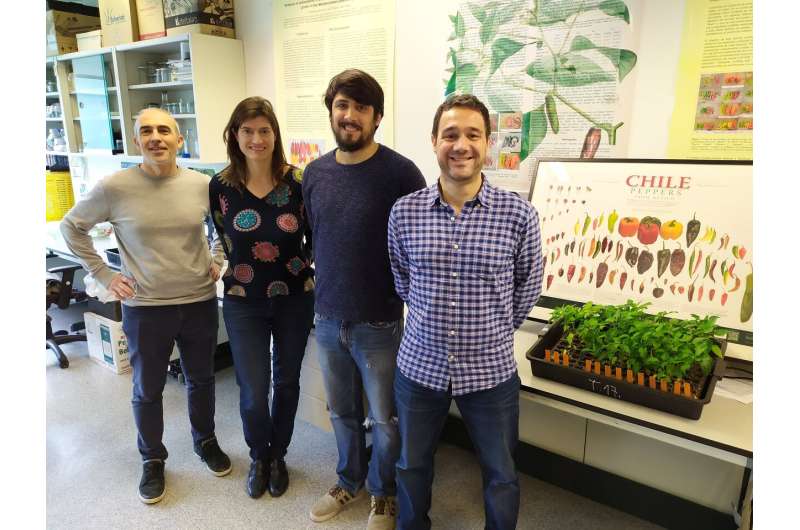Researchers obtain the most complete genetic map of peppers

The most complete genetic map of peppers cultivated in Spain has been created by Valencia's Polytechnic University (UPV). The results make it possible to learn the smallest detail of this crop, of which Spain is one of the main worldwide producers. And more importantly, they establish the bases for obtaining new landraces with better organoleptic properties, and which may even be more resistant to climate change.
"This study provides complete and relevant information on the origin and the relationships between local Spanish landraces. It also helps prevent fraud, as well as crossbreeding in improvement programs, in order to achieve practically on-demand peppers; for example, with more flavor, stronger colors or better resistance to pathogens or extreme climatic conditions," explains Adrián Rodríguez Burruezo, researcher at the Institute for the Conservation and Improvement of Valencian Agrodiversity (COMAV) of the UPV and person responsible for the study, which was recently published in specialised journal Horticulture Research.
190 landraces
The pepper (Capsicum annuum) is one of the most important vegetable crops in Spain. However, the genetic studies that had been done heretofore had been of a smaller scope compared to those conducted on other Solanaceae varieties such as tomatoes, potatoes or aubergines.
In this study, which is part of the doctoral dissertation of Leandro Pereira, the COMAV UPV researchers analyzed a collection of 190 pepper landraces—183 from cultivated species and 7 wild forms. Among the analyzed landraces were all the Spanish designations of origin, including the thick and sweet ones (Morrón bell peppers) and Valencian peppers, Trompa de Vaca, Largo de Reus, Morrón de Fresno y Benavente, de Infantes, de Asar vascos, etc…, and even types to be canned or processed, such as Piquillo, Bierzo, Riojano, Ñora/Bola de Murcia, Jaranda de la Vera, Gernika/choricreo, chili, Padrón, the yellow pepper of Mallorca or the white pepper of Villena, etc.
Furthermore, others from Europe and Asia were analyzed, as well as ones from the centers of domestication of Mexico and the U.S.: Jalapeños, Poblanos, Pasillas, Serranos (the oldest form cultivated), chiltepins (wild form), cayenne or Chilhuacle, as well as species linked to South America and the Caribbean (C. chinense, C. fruscens and C. baccatum): Habaneros and several Ají.
Mass genotyping
The analysis consisted of a mass genotyping-by-sequencing of the evaluated landraces, which revealed thousands of polymorphisms of SNP-type DNA. It is the most powerful tool to detect differences among landraces on a nucleotide level, the links of the DNA chain.
Comparing the landraces based on these polymorphisms made it possible to establish the phylogenetic relationships among them. For example, Valencian bell peppers represent a specific branch which in turn groups into a larger branch of thick Mediterranean peppers, such as the Largo de Reus or Trompa de Vaca de Murcia, which are clearly differentiated from the thick ones from Castilla-Leon (Bierzo and Fresno), the Basque Country and northern Spain.
Strong relationship with Mexican peppers
The work has verified the strong relationships between certain Spanish landraces and their Mexican forefathers, or from other parts of Europe. For example, Piquillo peppers are linked to Poblanos, and chilli peppers, with cayennes or Numex.
We have detected that Bola de Murcia, Piquillo and Pimiento de Mojo are on a common branch despite being morphologically different, as happens with the Morrón de Fresno y Benavente with the Bierzo pepper. Or a genetic lineage comprised by the Padrón, Gernika, Piment d'Espellette, Guindilla de Ibarra and Peperone di Senise peppers. Which shows that, in general, morphological similarity corresponds with genetics, but other times, geographic proximity (possibly common genetic flows or material exchange) is more decisive. This information is key to address the genetic improvement of a certain landrace.
Preventing fraud
Furthermore, the COMAV-UPV team has identified SNP polymorphisms that are specific to each landrace, information which is essential to establish in the near future the genetic fingerprint of designations of origin and other materials of acknowledged prestige and differentiated quality, thus helping prevent fraud and, for example, for peppers to be sold as D.O. peppers when in reality they aren't.
"Furthermore, it is also essential for the development and exploitation of experimental landraces that include features of agronomic interest, such as being resistant to stress and pathogens, the quality of the fruit, productivity, etc.," adds Rodríguez-Burruezo.
The study has made it possible to obtain the most detailed genetic map of peppers cultivated in Spain. "It is a project that provides information of great relevance for producers, data that was heretofore unknown on the origin and the relationships among local Spanish landraces," concludes Rodríguez-Burruezo.
More information: Leandro Pereira-Dias et al. Genetic diversity, population structure, and relationships in a collection of pepper (Capsicum spp.) landraces from the Spanish centre of diversity revealed by genotyping-by-sequencing (GBS), Horticulture Research (2019). DOI: 10.1038/s41438-019-0132-8
Provided by Asociacion RUVID




















